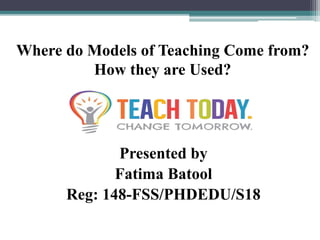
Models of teaching
- 1. Where do Models of Teaching Come from? How they are Used? Presented by Fatima Batool Reg: 148-FSS/PHDEDU/S18
- 2. Introduction • Researchers have developed a number of teaching strategies to realize specific instructional goals. • These teaching strategies show that there is no single best way to teach everything, • But different strategies are required to realize different instructional goals. • These prescriptive teaching strategies are known as 'Models of Teaching'.
- 3. Models of Teaching • Model of Teaching is a plan or pattern that can be used to: ▫ Shape curricula, ▫ Design instructional materials and ▫ Guide instruction in the classroom and other settings. • Models of Teaching helps students to acquire: ▫ Information ▫ Ideas, ▫ Skills, ▫ Values, ▫ Ways of thinking, and ▫ Means of expressing themselves (Joyce and Wei1,1997)
- 4. Emergence of Models of Teaching • During the last two decades, a lot of attention has been paid to improve the process of teaching • It results in the development of a number of models of teaching by various researchers. • All these models are based on empirical researches, theories, postulates and hypothetical propositions. • The work done by Joyce and Weil is monumental in this area.
- 5. Cont… • Models of Teaching are designed to: ▫ Engage students in particular cognitive and social tasks ▫ Help students learn to construct knowledge ▫ Increase students‘ ability to process information more powerfu1ly • The most comprehensive review of teaching models is given by Joyce and Weil (1980) who have identified 24 models • Which are classified into four basic families based on the nature, distinctive characteristics and effects of the models.
- 7. 1. Information Processing Models • These models refers to the ways people: ▫ Handle stimuli from the environment, ▫ Organize data, ▫ Generate concepts, and solutions to problems, ▫ Sense problems and ▫ Employ verbal and non verbal symbols.
- 8. 2. Personal Models • Models which belong to this family deal with the individual and the development of self hood. • The emphasis of these models is on developing an individual into an: ▫ Integrated, ▫ Confident and ▫ Competent personality. • They stimulate students to ▫ Understand themselves and their goals, ▫ Develop the means for educating themselves.
- 9. 3. Social Interaction Models • The models in this family emphasize the relationships of the individual to the society or other persons. • The core objective is to help students learn to: ▫ Work together. ▫ Identify and solve problems, either academic or social in nature.
- 10. 4. Behavior Modification Models • All the models in this family share a common theoretical base, a body of knowledge which referred to as behaviour theory. • The common thrust of these models is the emphasis on changing the visible behaviour of the learner.
- 11. Common Features • Models usually contain common features and these may include: ▫ An identified purpose or area of concentration ▫ Underlying explicit and implicit assumptions about the characteristics of learners and about the teaching-learning process
- 12. Cont… • Guidelines for developing specific educational experiences; • Definite patterns and requirements for each instructional event; • A body of research surrounding their development and implementation, and/or an evaluation of their effectiveness.
- 13. Functions of Teaching Models
- 14. Concepts for Describing a Model • In order to translate a theoretical model into practical teaching form, a set of four concepts are used: 1. Syntax: It is described in terms of sequences of activities which are called phases. Each model has a distinct flow of phases. 2. Principles of Reaction: They guide the teacher’s response to the learner, they tell the teacher how to regard the learner and respond to what he does.
- 15. Cont… 3. Social System: It provides a description of the student and teacher role and relationships and the kind of norms that are encouraged. The leadership role of the teacher varies greatly from model to model. 4. Support System: This refers to the additional requirements beyond the usual capacities and technical facilities necessary to be implemented in a model.
- 16. Effects of the Models • The description of the effects of model is categorized as the: ▫ Direct or instructional effects and ▫ Indirect or nurturant effects • The instructional effects are purposefully envisaged by a teacher and comes from the content taught using the model • The nurturant effect comes from experiencing the environment created by the model.
- 17. Summary
- 18. Thanks